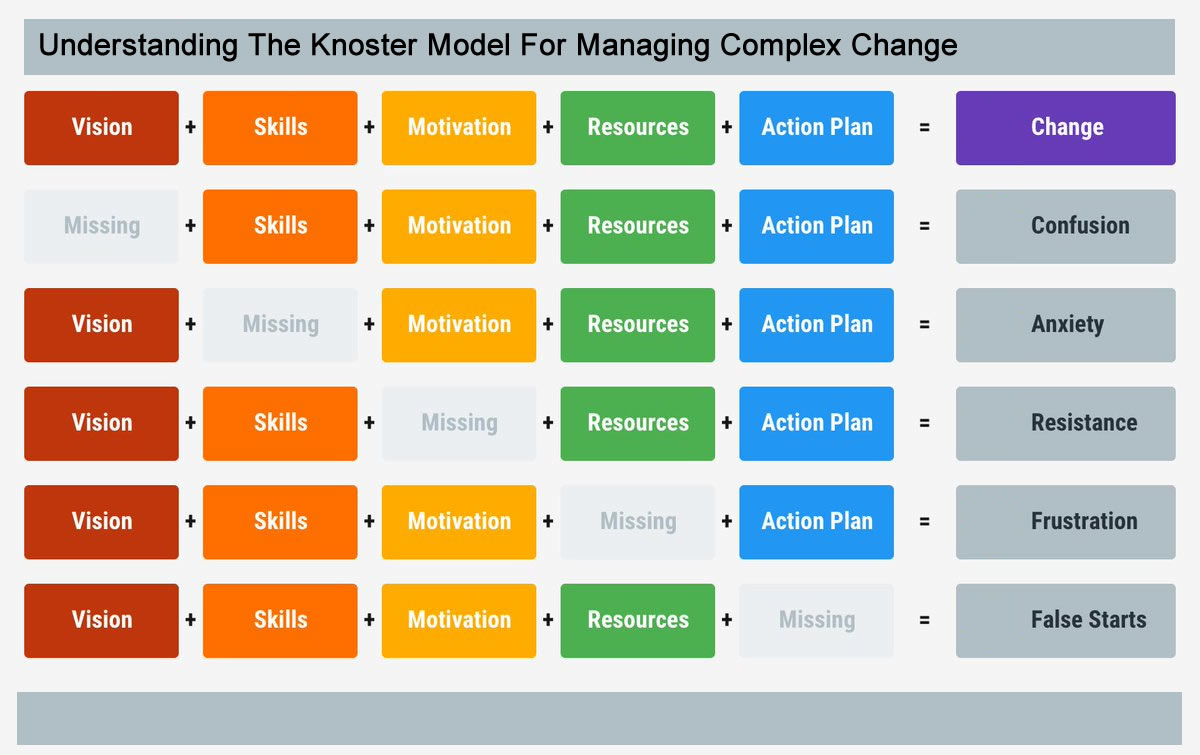Supercharging Educational Technology Sales: Leveraging the Knoster Model to Boost Service Offerings
How Can Integrating Change Management Strategies Help You Sell More Services?
According to research by McKinsey & Company, up to 70% of technology initiatives in school districts fail to meet their objectives (Mourshed, Chijioke, & Barber, 2010). This alarming statistic highlights the critical gap between product acquisition and successful implementation, a challenge that technology sales professionals must confront directly. This is where the Knoster Model for Managing Complex Change comes into play. By integrating this powerful framework into your sales strategy, you can effectively position your training, consulting, and other services as essential components of a holistic solution, ultimately leading to increased sales and revenue.
The Knoster Model breaks down the complex process of change into five key elements: Vision, Skills, Incentives, Resources, and Action Plan. By addressing each of these areas, you can demonstrate to potential clients that your services are not just add-ons, but critical drivers of success. Let's explore how you can leverage the Knoster Model to supercharge your educational technology sales.
Vision: The Cornerstone of Change
When pitching your software, don't just focus on features; paint a vivid picture of the transformative impact it can have on teaching and learning. Highlight how your training and consulting services can help districts and schools to articulate and achieve their unique vision for technology integration. For example, share a success story of a school district that, with the help of your consulting services, crafted a clear, compelling vision for blended learning that resonated with all stakeholders and led to increased buy-in and adoption.
Skills: Bridging the Gap Through Training
Emphasize how your instructional design and training offerings can bridge the skills gap and empower educators to effectively utilize your software. Showcase the impact of your training programs using data-driven case studies and demonstrating ROI through pre- and post-training assessments. For instance, highlight a district that saw a 50% increase in technology adoption rates and a 20% improvement in student engagement scores after implementing your comprehensive training program.
Incentives: Igniting Motivation for Change
Highlight how your consulting services can help schools develop incentive programs that drive technology adoption and ensure a strong return on investment. Share examples of effective incentive strategies, such as gamification techniques or micro-credentialing that reward teachers for completing training modules or implementing technology-enhanced lessons. Provide a case study of a district that successfully used your consulting services to design and implement an incentive program that led to a measurable increase in teacher participation and/or reduction in support requests.
Resources: Overcoming Obstacles to Success
Address potential resource constraints head-on by showcasing how your services can help schools optimize their technology investments. Share a case study of a client who leveraged your consulting services to develop a strategic resource allocation plan that prioritized high-impact initiatives and resulted in an increase in ROI. Provide actionable tips for sales professionals, such as using total cost of ownership (TCO) analyses to demonstrate the long-term value of your services.
Action Plan: Mapping the Path to Success
Present your services as the key to a seamless and successful implementation process. Offer a clear, step-by-step action plan that outlines how your services will support stakeholders at every stage, from initial planning to post-deployment support. Share a visual timeline that illustrates the critical milestones and deliverables of your implementation process, highlighting the specific ways in which your services ensure success at each stage.
Overcoming Objections
When selling services alongside software, sales professionals may face objections related to cost, necessity, or timing. Use the Knoster Model to address these objections proactively:
Cost: Demonstrate how your services help schools maximize the value of their technology investments, leading to improved ROI and long-term cost savings.
Necessity: Highlight the critical role your services play in driving successful adoption and implementation, using case studies and data to illustrate their impact.
Timing: Emphasize the importance of planning for change management from the outset and show how your services can be tailored to meet the unique needs and timelines of each school.
Beyond Sales: Cultivating Partnerships for Change
By leveraging the Knoster Model in your sales strategy, you can effectively communicate the value of your services, positioning them not as optional extras, but as critical components of a successful educational technology implementation. By doing so, you differentiate yourself from competitors, build stronger client relationships, and ultimately drive increased sales and revenue.
To get started, take these actionable steps:
Review your current sales approach and identify opportunities to incorporate change management strategies.
Develop a set of compelling case studies and data points that showcase the impact of your services on technology adoption, ROI, and student outcomes.
Create a visual aid, such as an infographic or presentation, that illustrates how your services align with the Knoster Model and drive success at each stage of the implementation process.
Set specific, measurable goals for increasing service sales and track your progress over time. By embracing this framework and committing to ongoing improvement, you can position yourself as a leader in the field and make a lasting impact on the future of education.
By embracing the power of the Knoster Model and implementing these strategies, you'll be well on your way to supercharging your sales attainment and making a lasting impact on the future of education.




